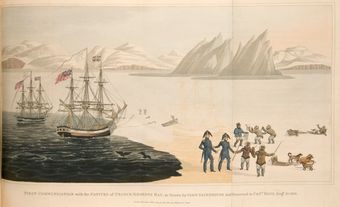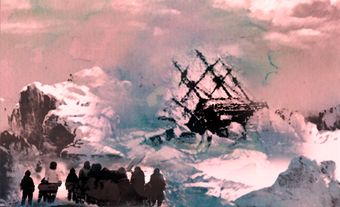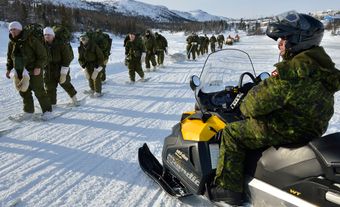In the 1920s, the Canadian government attempted to assert its sovereignty in the High Eastern Arctic by establishing Royal Canadian Mounted Police (RCMP) posts. Eastern Arctic Patrols were annual summer expeditions by ship to set up and resupply these detachments. From 1922 to 1968, the patrol transported police, geologists, scientists, medical professionals and government officials north, bringing supplies and medical services to Eastern Arctic communities. The last patrol ship, CD Howe, was also used to relocate people from northern Quebec (Nunavik) to remote High Arctic locations for sovereignty purposes. (See Inuit High Arctic Relocations in Canada.)

Sovereignty and Eastern Arctic Patrols
In the 1920s, Canada faced perceived threats to its Arctic territory. Although the Canadian Arctic Expedition (1913–18) had asserted sovereignty in the Arctic archipelago, Canadian claims carried little weight in international law because the area had not been effectively occupied or administered. Expeditions by American, Norwegian and Danish explorers were also a threat to Canadian sovereignty. Furthermore, the Canadian government was concerned to learn that Greenlandic Inughuit were crossing to Ellesmere Island to hunt, thus providing some basis for a Danish claim.
In response, the Canadian government decided to assert sovereignty by setting up RCMP posts at key locations in the High Eastern Arctic. RCMP officers would live there year-round and carry out dogsled patrols. The Eastern Arctic Patrol carried men and materials to build and supply the posts and monitored activity in Canadian Arctic waters.

Early Patrols: Arctic (1922–25)
The wooden sailing-steam ship Arctic, captained by Joseph-Elzéar Bernier, carried out the first four Eastern Arctic Patrols (1922–25). The ship was under the command of a civil servant and transported government officials, medical doctors, scientists, geologists and RCMP officers, as well as supplies and building materials for police posts. Each year, Arctic left Quebec City in July and returned in October.
The government wanted a key post established at Bache Peninsula on eastern Ellesmere Island opposite Etah, Greenland, where Inughuit supposedly crossed over to hunt muskox. However, all four summers, ice blocked Arctic from accessing the harbour at Bache Peninsula.
After ice thwarted efforts to establish the detachment at Bache, the 1922 expedition built a post in a sheltered bay on southern Ellesmere Island. It was named Craig Harbour after the expedition’s commanding officer, J.D. Craig. A second post was also built at Pond Inlet. The 1923 Eastern Arctic Patrol built a third post at Pangnirtung in Cumberland Sound on Baffin Island.
Did you know?
From 1923 on, the patrol recruited Inughuit families from Greenland to assist the police living at the Ellesmere Island posts. Ironically, the Eastern Arctic Patrol was intended to prevent Greenlanders coming to Ellesmere.

In 1924, the patrol discovered the house at Craig Harbour had burned down and the officers were living in a shed. They rebuilt the post with materials for the Bache detachment. A fourth post was built at the Dundas Harbour site on Devon Island. In 1924, the materials for the Bache post were used to construct a supply depot at the Kane Basin. The RCMP made numerous sledding journeys to it from Craig Harbour.
Murder Trial 1923
The 1923 expedition also carried a legal party for a trial at Pond Inlet for the murder of Newfoundland trader Robert Janes. This first court case in the Arctic was a sham. The language and cultural barriers between the two groups resulted in a miscarriage of justice. A man, Nuqallaq, was found guilty of manslaughter and sentenced to 10 years at Stony Mountain Penitentiary in Manitoba. He was taken south on the ship but returned in 1925 after contracting tuberculosis in prison.

Beothic (1926–31)
The 1925 patrol was Arctic’s final voyage. A stronger steel-hulled vessel was required for Arctic ice conditions. In 1926, the government chartered the steamer Beothic, a 2,000-ton steel-hulled Newfoundland sealer. Beothic succeeded in pushing through the ice, and a post was finally built at Bache Peninsula. This was the most northerly police detachment in the world. Craig Harbour remained open, leaving two posts on Ellesmere Island until Bache closed in 1933.
From 1926 to 1931, the Eastern Arctic Patrol aboard Beothic visited and resupplied posts at Craig Harbour, Dundas Harbour, Arctic Bay, Pond Inlet, Clyde River and Pangnirtung.
SS Nascopie (1932–47)
During the summer of 1932, the Eastern Arctic Patrol used SS Ungava. In 1933, the RCMP teamed up with the Hudson’s Bay Company (HBC), gaining annual passage aboard the HBC supply ship SS Nascopie. HBC had trading posts in communities on Baffin Bay, Hudson Strait, Hudson Bay and the central Arctic. The RCMP could then set up more detachments and visit more outposts. Nascopie sank in July 1947 off Cape Dorset (Kinngait) on southwestern Baffin Island. Several vessels (including MV Regina Polaris) were used to resupply posts from 1947 to 1949; in addition, government inspectors and members of the RCMP were flown in by plane.

CGS CD Howe (1950–68): Medical and Dental Services
In 1950, the patrol resumed in the 3,600-ton ice-strengthened ship CD Howe, owned by the Department of Transport. The scope of the patrol had expanded to include six other federal departments: Resources and Development, National Health and Welfare, Transport, Mines and Technical Surveys, Justice and the Post Office. The patrol continued to resupply Eastern Arctic communities, but focus shifted to providing medical and dental services.

In 1953 and 1955, C.D. Howe was used to relocate people from their homeland in northern Quebec and Pond Inlet to Grise Fiord on Ellesmere Island and Resolute Bay on Cornwallis Island. (See Inuit High Arctic Relocations in Canada, John Amgoalik). In 1959, the patrol, commanded by a senior doctor, became a hospital ship with two doctors, two dentists and two nurses. It was authorized to test all Inuit for tuberculosis. Those who tested positive were kept aboard ship and taken south for treatment without notifying their families. People were often screened against their will.
In 1968, National Health and Welfare decided that since most Inuit were moving into communities with nursing stations, The C.D. Howe medical service was no longer necessary. Airplanes also made it easier to access dental services. For these reasons, the Eastern Arctic Patrol was discontinued.


 Share on Facebook
Share on Facebook Share on X
Share on X Share by Email
Share by Email Share on Google Classroom
Share on Google Classroom





